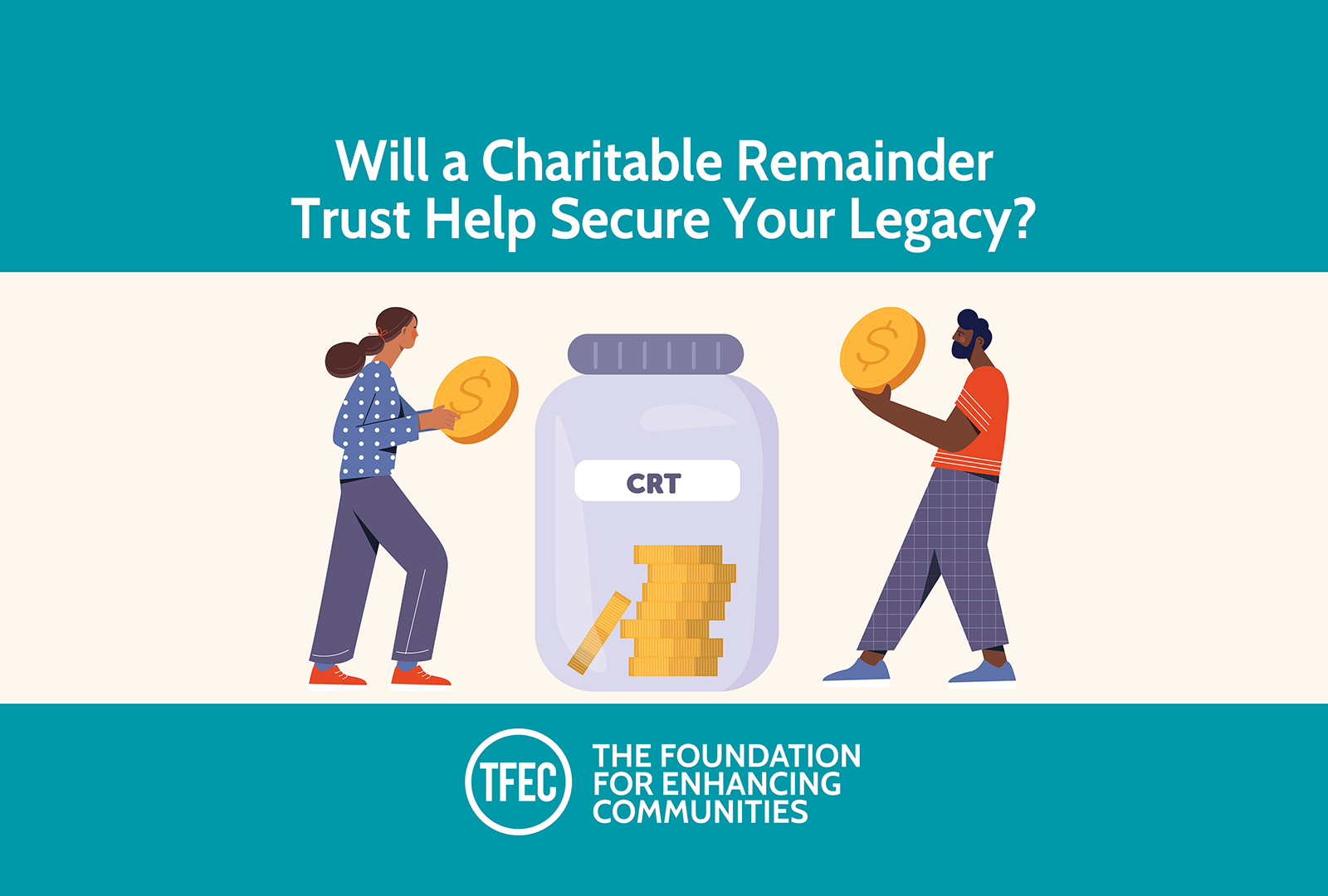A charitable remainder trust (CRT) allows you to pursue your philanthropic goals while generating income. It is a type of trust that allows you to donate assets to charity while also drawing annual income from it for yourself or a beneficiary.
The Foundation for Enhancing Communities (TFEC) manages and serves as the trustee for 59 charitable trusts valued at $12,198,174 as of 5/31/2024. These trusts include CRTs and charitable remainder annuity trusts. Legal agreements transfer the assets irrevocably to the trust and TFEC then administers the trust. TFEC sends the beneficiaries of each trust income on a quarterly basis for the rest of their lives. Income that is annually paid out of a trust is taxable to the beneficiary. At years end TFEC prepares the tax return for the trust and sends each beneficiary a document which they can use when preparing their individual taxes. A donor may establish these legacy gifts in order to increase the impact of their charitable gifts, receive a lifetime income and/or qualify for income, gift and estate tax benefits. Charitable trusts have a minimum $50,000 contribution requirement.
Benefits of a CRT
Setting up a CRT can help you in the following ways:
- Plan major donations to charities you support.
- Provide a predictable income for life or over a specific time period.
- Allows you to defer income taxes on the sale of assets transferred to the trust.
- May allow you a partial charitable deduction based on the value of the charitable interest in the trust.*
Looking at what kinds of assets are suitable for CRTs, the trust can invest in the same asset categories that can be used to fund it. What that means is that, with a few limitations, you can invest in all kinds of stock, cryptocurrency, real estate, alternative assets and tangible personal property.
“CRTs are a valuable tool for charitable-minded individuals, and should be considered while designing a tax efficient financial plan,” said Alex Langan, Chief Investment Officer, Langan Financial Group.
Gift of Real Estate Example
Let’s further explore an example of real estate to explain how these assets are managed and distributed in a CRT.
Imagine you bought a tract of land 10 years ago for $200,000 and now you could sell it for $2 million because of the market. Instead of simply selling the land, you can secure an income stream for the rest of your life, in addition to satisfying your charitable goals and capitalizing on the property’s high value.
For example, in our hypothetical situation, you could establish the CRT and resultant fund at TFEC to receive the CRT’s assets following the termination of the income stream, in this case, upon your or your beneficiary’s death. Your fund at TFEC can provide for distribution of those assets to hospice, animal rescue or the art museum according to your charitable goals and wishes.
Because the charitable remainder trust qualifies as a charitable entity under the Internal Revenue Code, here’s what happens from a tax perspective:
- When you transfer the property to the CRT at a fair market value of $2 million with a cost basis of $200,000, and then the CRT sells the property, the CRT itself does not pay tax on the $1.8 million capital gain.
- This leaves the full $2 million in the trust to be invested, subject to your retained income stream.
- You are eligible for a charitable tax deduction of the fair market value of the property given to the trust, minus the present value of the retained income stream.
- Payments to you are subject to income tax during each year of the distributions, but under more favorable terms than if you had conducted an outright sale.
- Because the CRT is an irrevocable trust, the property and its proceeds (other than what winds up in your estate from the retained income stream) are excluded from your estate for estate tax purposes.
Contrast this with an alternative scenario in which you sell the property, realize a $1.8 million capital gain, pay tax on that gain and end up with, say, $1.5 million (probably less!) with which to invest, give to charity and draw from for income. And, in this situation, the proceeds would be included in your estate for estate tax purposes. Ouch!
Set Up Your CRT with TFEC
You may be asking — are there any pitfalls to a CRT? Well, because CRTs are irrevocable trusts, once it is set up, the trustor has no access or control in the trust. This makes it almost impossible to change its features. As such, individuals need to be 100% sure this what they want before implementing this option. This is where TFEC and financial planners come into play, we work with you to make sure this is the right path to a tax efficient financial plan and securing your legacy.
Now that you know a little more about CRTs, ask yourself will a charitable remainder trust help secure my legacy? If the answer is yes or even if you are still unsure, contact TFEC today at 717.236.5040 or philanthropy@tfec.org.
References: *(Internal Revenue Service, 2023)

